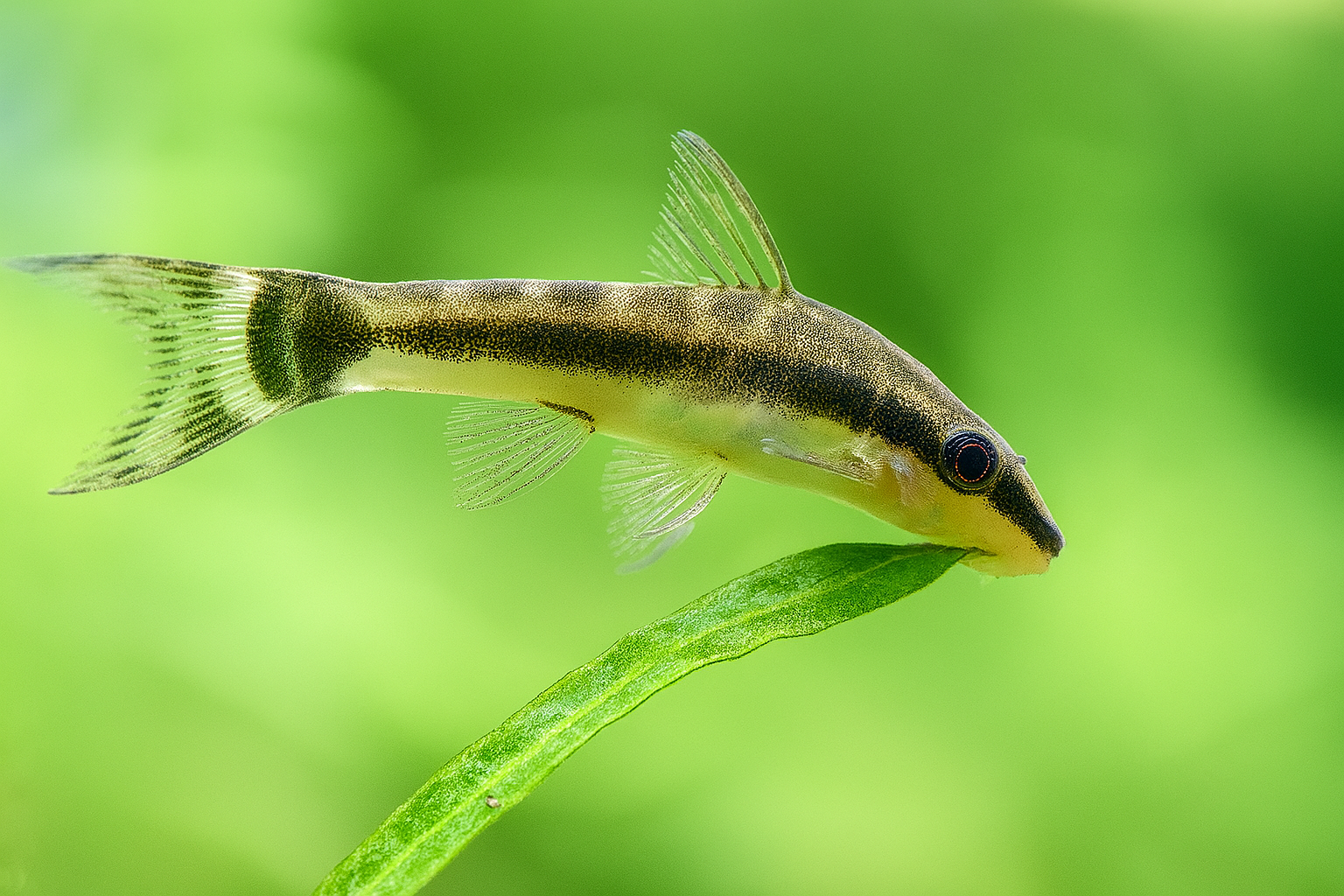
Zebra Otocinclus (Local Bred)
The Zebra Otocinclus (Otocinclus cocama) is a strikingly patterned, peaceful freshwater algae-eater native to Peru. Known for its bold black-and-white striping, this rare species stands out among the Otocinclus genus. It’s a prized addition to aquascaped tanks due to its small size, peaceful nature, and algae-eating habits. Proper care and stable water parameters are key to keeping this sensitive but rewarding species.
Common Name: Zebra Oto
Scientific Name: Otocinclus cocama
Origin:
Upper Ucayali River, Peru (Amazon River Basin).
Maximum Size:
1.5–2 inches (3.8–5 cm)
Zebra Otocinclus Care:
Tank Parameters Required:
Minimum Tank Size: 15 gallons (57 liters) for small groups.
pH Range: 6.5–7.5 (slightly acidic to neutral).
Hardness: 3–15 dGH (soft to moderate).
Temperature: 22–26°C (72–78°F)
Temperament:
Very peaceful, shy, and best kept in groups of at least 5–6.
Tank Level:
Primarily bottom and glass dwellers; often seen grazing on plant leaves, driftwood, and surfaces throughout the tank.
Diet:
Herbivores. Mainly eat algae and biofilm. Supplement with:
Algae wafers
Blanched vegetables (zucchini, spinach, cucumber)
Occasional spirulina-based flakes or gel foods
Note: Ensure a mature tank with established algae growth for optimal health.
Tank Decor:
Soft sand or smooth gravel substrate.
Plenty of live plants, driftwood, and shaded areas.
Smooth surfaces for algae growth and grazing.
Low to moderate water flow with excellent oxygenation.
Breeding:
Breeding is rare in captivity but possible in heavily planted, stable tanks. Eggs are laid on surfaces like plant leaves or tank glass. Cooler water changes and abundant food can help trigger spawning.
Behavior:
Active but shy. Spend most of their time grazing for algae. Social and peaceful; thrive when kept in groups. They are highly sensitive to poor water quality and fluctuations, so stable conditions are crucial.
Suitable Tank Mates:
Peaceful nano fish like chili rasboras, celestial pearl danios, small tetras.
Ideal with shrimp and other gentle bottom-dwellers like Corydoras.
Avoid larger or aggressive fish, which can stress or outcompete them.
Maintenance:
Perform 25–30% water changes weekly.
Ensure stable, clean water with minimal nitrates.
Use a sponge or pre-filter to avoid sucking in small Otos.
Difficulty:
Moderate. More sensitive than common Otocinclus species. Best kept by aquarists with some experience and access to a well-cycled, algae-rich tank.
Caring for Zebra Otocinclus is a visually and biologically rewarding experience. Their unique pattern and algae-cleaning behavior make them a standout in any peaceful planted aquarium. With proper attention to water quality and diet, they can thrive for up to 3–5 years in captivity.
The Zebra Otocinclus (Otocinclus cocama) is a strikingly patterned, peaceful freshwater algae-eater native to Peru. Known for its bold black-and-white striping, this rare species stands out among the Otocinclus genus. It’s a prized addition to aquascaped tanks due to its small size, peaceful nature, and algae-eating habits. Proper care and stable water parameters are key to keeping this sensitive but rewarding species.
Common Name: Zebra Oto
Scientific Name: Otocinclus cocama
Origin:
Upper Ucayali River, Peru (Amazon River Basin).
Maximum Size:
1.5–2 inches (3.8–5 cm)
Zebra Otocinclus Care:
Tank Parameters Required:
Minimum Tank Size: 15 gallons (57 liters) for small groups.
pH Range: 6.5–7.5 (slightly acidic to neutral).
Hardness: 3–15 dGH (soft to moderate).
Temperature: 22–26°C (72–78°F)
Temperament:
Very peaceful, shy, and best kept in groups of at least 5–6.
Tank Level:
Primarily bottom and glass dwellers; often seen grazing on plant leaves, driftwood, and surfaces throughout the tank.
Diet:
Herbivores. Mainly eat algae and biofilm. Supplement with:
Algae wafers
Blanched vegetables (zucchini, spinach, cucumber)
Occasional spirulina-based flakes or gel foods
Note: Ensure a mature tank with established algae growth for optimal health.
Tank Decor:
Soft sand or smooth gravel substrate.
Plenty of live plants, driftwood, and shaded areas.
Smooth surfaces for algae growth and grazing.
Low to moderate water flow with excellent oxygenation.
Breeding:
Breeding is rare in captivity but possible in heavily planted, stable tanks. Eggs are laid on surfaces like plant leaves or tank glass. Cooler water changes and abundant food can help trigger spawning.
Behavior:
Active but shy. Spend most of their time grazing for algae. Social and peaceful; thrive when kept in groups. They are highly sensitive to poor water quality and fluctuations, so stable conditions are crucial.
Suitable Tank Mates:
Peaceful nano fish like chili rasboras, celestial pearl danios, small tetras.
Ideal with shrimp and other gentle bottom-dwellers like Corydoras.
Avoid larger or aggressive fish, which can stress or outcompete them.
Maintenance:
Perform 25–30% water changes weekly.
Ensure stable, clean water with minimal nitrates.
Use a sponge or pre-filter to avoid sucking in small Otos.
Difficulty:
Moderate. More sensitive than common Otocinclus species. Best kept by aquarists with some experience and access to a well-cycled, algae-rich tank.
Caring for Zebra Otocinclus is a visually and biologically rewarding experience. Their unique pattern and algae-cleaning behavior make them a standout in any peaceful planted aquarium. With proper attention to water quality and diet, they can thrive for up to 3–5 years in captivity.









